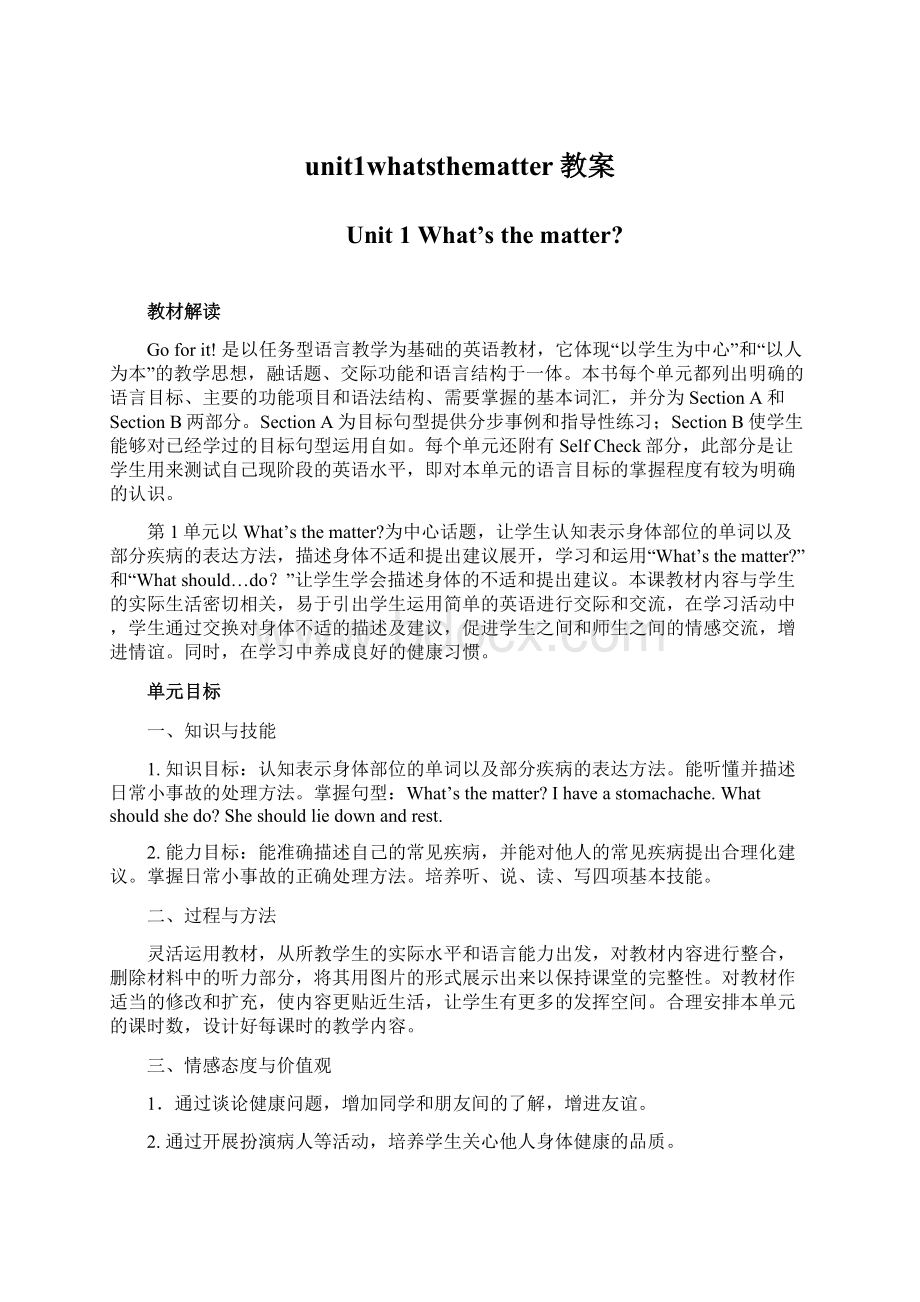 unit1whatsthematter教案Word格式文档下载.docx
unit1whatsthematter教案Word格式文档下载.docx
- 文档编号:14542156
- 上传时间:2022-10-23
- 格式:DOCX
- 页数:18
- 大小:32.67KB
unit1whatsthematter教案Word格式文档下载.docx
《unit1whatsthematter教案Word格式文档下载.docx》由会员分享,可在线阅读,更多相关《unit1whatsthematter教案Word格式文档下载.docx(18页珍藏版)》请在冰豆网上搜索。

单元目标
一、知识与技能
1.知识目标:
认知表示身体部位的单词以及部分疾病的表达方法。
能听懂并描述日常小事故的处理方法。
掌握句型:
What’sthematter?
Ihaveastomachache.Whatshouldshedo?
Sheshouldliedownandrest.
2.能力目标:
能准确描述自己的常见疾病,并能对他人的常见疾病提出合理化建议。
掌握日常小事故的正确处理方法。
培养听、说、读、写四项基本技能。
二、过程与方法
灵活运用教材,从所教学生的实际水平和语言能力出发,对教材内容进行整合,删除材料中的听力部分,将其用图片的形式展示出来以保持课堂的完整性。
对教材作适当的修改和扩充,使内容更贴近生活,让学生有更多的发挥空间。
合理安排本单元的课时数,设计好每课时的教学内容。
三、情感态度与价值观
1.通过谈论健康问题,增加同学和朋友间的了解,增进友谊。
2.通过开展扮演病人等活动,培养学生关心他人身体健康的品质。
3.通过本课的阅读,培养学生处理紧急事件的基本能力,以及发生紧急事件时互相帮助的精神。
教法导航
1.以任务型教学作为课堂教学理念、利用整体语言教学法、情景教学法、交际教学法等。
2.在教学中创设切实可行的任务型教学活动、突出交际性。
3.教师为主导、学生为主体、任务为基础,注重实用性。
4.引趣激趣策略,创设情景调节气氛,引发激发学生兴趣。
学法导航
多读善思,小组合作、探究、学习、交流。
课时支配:
第1课时:
SectionA1a-2d
第2课时:
SectionA3a-4c
第3课时:
SectionB1a-2e
第4课时:
SectionB3a-SelfCheck
课时教案
第1课时SectionA1a-2d
教学目标
1.熟练读出,拼写本节课的表示身体部位的单词。
2.能听懂健康问题及解决建议。
3.掌握常见的询问健康的问题及答语。
看图法,对话,做游戏,多种方法并用,促使学生主动探求知识。
通过学习本课,培养学生关心自己和他人的健康,增进彼此间的友谊。
教学重点
学会询问并回答有关健康的问题,并能给出合理的建议。
教学难点
掌握重点句型:
Ihaveafever.Youshouldtakeyourtemperature.
通过看图、听录音、对话、讨论等方法学习谈论健康及提出建议。
学法导航
通过看、听、说等各种途径,以小组合作的形式,主动探求知识,锻炼自主学习能力。
教学准备
图片,多媒体。
教学过程
Step1Warmingupandnewwords
Lookatapictureandlearnthepartsofthebody.Thenshowthewordsonthescreen.Askthestudentstoreadandrememberthem.
Step2Presentation
1aLookatthepicture.Writethecorrectletter[a-m]foreachpartofthebody.
___arm___back___ear___eye___foot
___hand___head___leg___mouth
___neck___nose___stomach___tooth
Step3Game
Askallthestudentstostandupandplayagame:
Theteachersays“head”,thenallthestudentsshouldpointattheirheads.Thentheteachersaysotherpartsofthebody.Afterseveraltimes,asksomestudentstosayandthereststudentstodotheactions.
Step4Listening
1bListenandlookatthepicture.Thennumberthenames1-5.
Listentotheconversationsagainandfillintheblanks.
Conversation1
Nurse:
What’sthematter,Sarah?
Girl:
I___________.
Conversation2
What’sthematter,David?
Boy:
I_________________.
Conversation3
What’sthematter,Ben?
Conversation4
What’sthematter,Nancy?
Conversation5
Betty:
What’sthematter,Judy?
Ann:
She__________________.
Step5Speaking
1cLookatthepictures.Whatarethestudents’problems?
Makeconversationslikethis:
A:
What’sthematterwithJudy?
B:
Shetalkedtoomuchyesterdayanddidn’tdrinkenoughwater.Shehasaverysorethroatnow.
Makeupdialoguesaboutthestudents’problemsaftertheexample.
Step6Guessinggames
Guesswhathashappenedtothestudentsbyusingtheimportantsentences.
Step7Listening
2aListenandnumberthepictures[1-5]intheorderyouhearthem.
2bListenagain.Matchtheproblemswiththeadvice.
Step8Speaking
2cMakeconversationsusingtheinformationin2aand2b.
Myheadfeelsveryhot.
Maybeyouhaveafever.
WhatshouldIdo?
Youshouldtakeyourtemperature.
Step9Role–play
Imagineyouaretheschooldoctor.Afewstudentshavehealthproblems.Role-playaconversationbetweenthedoctorandthestudents.
2dRole–playtheconversation
Step10Languagepointsandsummary
1.What’sthematter?
这是人们特别是医生和护士询问病人病情时最常用的问句,意思是“怎么了?
”其后通常与介词with连用。
类似的问句还有:
What’swrong?
怎么啦?
What’swrongwithyou?
你怎么了?
What’syourtrouble?
What’sthetroublewithyou?
What’sup?
2.haveacold伤风,感冒,是固定词组。
表示身体不适的常用词组还有:
haveabadcold重感冒,haveafever发烧,haveaheadache头痛,haveastomachache胃痛,haveatoothache牙痛,haveabackache背疼,haveasorethroat喉咙疼
3.针对身体不适常提的建议:
liedownandrest躺下并且休息,drinkhotteawithhoney喝热蜂蜜茶,drinklotsofwater喝大量水,seeadentist看牙医,takeone’stemperature量体温,gotoadoctor看医生.
Step11Homework
Makeupaconversationbetweenadoctorandapatient.
课堂作业
翻译下列句子。
1.你怎么了?
我头痛。
2.他怎么了?
他发烧
3.李雷怎么了?
他喉咙痛。
他应该多喝水。
4.如果你的头和脖子明天仍然疼的话,请去看医生。
参考答案:
Ihaveaheadache.2.What’sthematterwithhim?
Hehasafever.3.What’sthematterwithLiLei?
Hehasasorethroat.Heshoulddrinkenoughwater.4.Ifyourheadandneckstillhurttomorrow,thengotoadoctor.
教学反思
学生对自己的身体部位很熟悉,也很愿意学习有关身体部位的单词,比较容易调动学生的学习积极性。
尤其是学完身体部位的名称后做的小游戏,学生很感兴趣,班内气氛活跃,学习效果很好。
第2课时SectionA3a-4c
1.熟练掌握询问、回答有关健
- 配套讲稿:
如PPT文件的首页显示word图标,表示该PPT已包含配套word讲稿。双击word图标可打开word文档。
- 特殊限制:
部分文档作品中含有的国旗、国徽等图片,仅作为作品整体效果示例展示,禁止商用。设计者仅对作品中独创性部分享有著作权。
- 关 键 词:
- unit1whatsthematter 教案
 冰豆网所有资源均是用户自行上传分享,仅供网友学习交流,未经上传用户书面授权,请勿作他用。
冰豆网所有资源均是用户自行上传分享,仅供网友学习交流,未经上传用户书面授权,请勿作他用。


 12处方点评管理规范实施细则_精品文档.doc
12处方点评管理规范实施细则_精品文档.doc
 17种抗癌药纳入国家基本医疗保险工伤保险和生育保险药品目录_精品文档.xls
17种抗癌药纳入国家基本医疗保险工伤保险和生育保险药品目录_精品文档.xls
